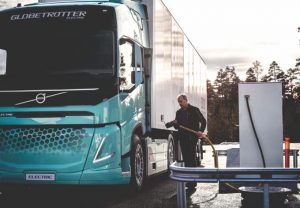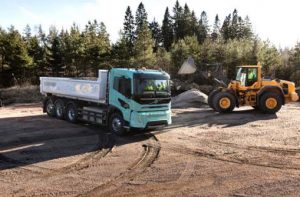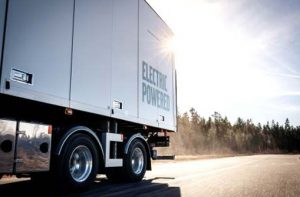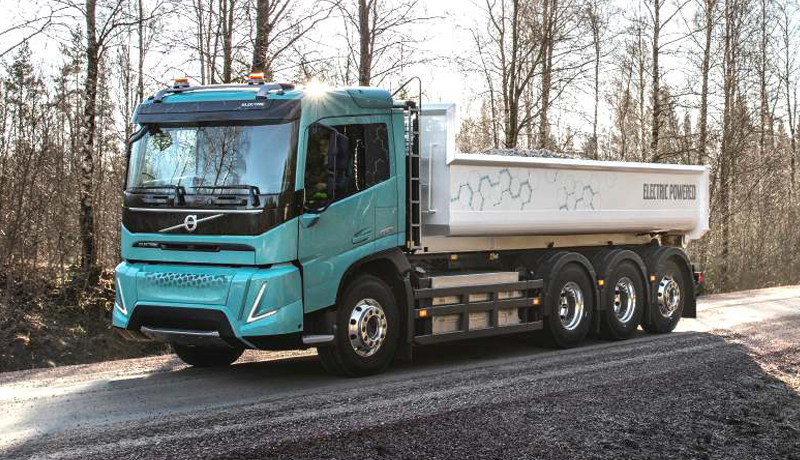Volvo Trucks introduces heavy-duty electric concept trucks for construction operations and regional transport
Select customers in Europe to pilot a small number of future heavy-duty electric vehicles with more extensive commercialization to follow
How can the environmental and climate impact of heavy Hgoods traffic be reduced while the demand for transport continues to increase?
Volvo Trucks, having recently started sales of electric trucks for urban transport, believes that electrification can become a competitive alternative also for heavier trucks. To explore and demonstrate the possibilities, Volvo Trucks has developed electric concept trucks for construction operations and regional distribution.
“We see great potential for heavy-duty electric trucks for regional transport and construction in the longer term. With our concept trucks, we aim to explore and demonstrate different solutions for the future while evaluating the level of interest in the market and in society. To increase demand for electrified trucks, the charging infrastructure needs to be rapidly expanded, while stronger financial incentives must be created for hauliers who act as pioneers by choosing new vehicles with a lower environmental and climate footprint,” said Roger Alm, President Volvo Trucks.
Heavy duty electric trucks can help improve the work environment for drivers and construction workers thanks to low noise level and zero exhaust emissions during operation. The latter will have a significant and positive effect on air quality in cities with many ongoing construction projects.
Due to the lack of noise disturbance, these trucks also make it possible to perform transport operations for more hours per day which opens up new possibilities for streamlining operations, for instance in large construction projects and for transports in and around cities.
A reduction of the overall climate impact of the transport sector is possible by using heavy electric vehicles in regional distribution. The majority of goods distribution by truck within the EU is regional.
“In Europe, there is an enormous number of trucks used for regional goods transport that have an average annual mileage of 80,000 km. This means that increased use of electric vehicles for regional distribution would result in significant climate gains, provided the electricity is fossil-free,” said Lars Mårtensson, Director Environment and Innovation, Volvo Trucks.
 Roger Alm, President Volvo Trucks
Roger Alm, President Volvo Trucks
We see great potential for heavy-duty electric trucks for regional transport and construction in the longer term. With our concept trucks, we aim to explore and demonstrate different solutions for the future while evaluating the level of interest in the market and in society. To increase demand for electrified trucks, the charging infrastructure needs to be rapidly expanded, while stronger financial incentives must be created for hauliers who act as pioneers by choosing new vehicles with a lower environmental and climate footprint.
Volvo Trucks’ plan for electric heavy-duty trucks for construction and regional distribution is to start by having selected customers in Europe pilot a small number of future electric vehicles. More extensive commercialization will follow at a later point.
“The speed of electrification will depend on a number of factors. On the one hand, an extensive expansion of the charging infrastructure is needed, and on the other hand it’s necessary to ensure that regional power networks can deliver sufficient transfer capacity in the long term.
“Financial incentives are necessary to induce more hauliers to invest in electric vehicles. Transport buyers can also contribute by offering longer contracts and being more willing to pay for sustainable transports. Many haulage operators have very small margins, so every new investment must be profitable,” explains Mårtensson.
In parallel with increased electrification of the transport sector, ongoing improvement of the efficiency of combustion engines will continue to play a key role for long haul truck transport for many years to come.
“Today’s truck engines are efficient energy converters that can run on diesel or various renewable fuels such as liquefied biogas or HVO, and the technology still has potential for further development,” Mårtensson noted.
 What role can Machine Learning play in the trucking industry?
What role can Machine Learning play in the trucking industry?
Machine Learning is a term that often get thrown around a lot, particularly in an exaggerated and unrealistic futuristic context. The truth though is that the technology is very much part of our lives already today and benefiting many industries including trucking.
Here is a look at what Machine Learning is enabling for logistics and trucking today and what opportunities it could present in the future.
Let’s start by discussing what Machine Learning is. The term was added to our vocabulary in 1959 by Arthur Samuel, a pioneer in computer gaming and artificial intelligence (AI). Machine learning is a branch of AI founded on the premise that systems can learn from data, identify patterns and provide effective and reliable predictions with minimum human intervention.
Machine Learning is often confused with Deep Learning, a subset of Machine Learning that is inspired by the information processing patterns of the human brain. Deep Learning is often thought of as the next step in Machine Learning as it can learn from its own method of computing and be more accurate in things such as image recognition and natural language processing.
Machine Learning has been around for a long time. But it has truly exploded over the last couple of years thanks to
advancements in computer processing and cloud computing which has allowed for the scaling and analysis of massive amounts of data.
Today Machine Learning exists in every corner of our lives; ever listened to a song recommended by Spotify? Used a virtual personal assistance like Alexa? Or planned a trip with a GPS navigation service or transported goods for an e-commerce customer? Then you have made use of Machine Learning.
Machine Learning is everywhere and trucking is no different. Given the massive amount of data the industry generates through connected vehicles, electronic logging devices, sensors and more, it’s likely to be gain even more traction.
Some areas where Machine Learning is already being applied in trucking include back office automation, route optimization, predictive maintenance and driver development. It is also a key component in the development of technologies like platooning and digital load matching platforms.
But this is just scratching the surface of what Machine Learning can do for the trucking industry. Looking into the future, the technology will continue to evolve, make better predictions in increasingly complex environments and solve the industry’s biggest challenge. Here is a look at some areas where Machine Learning will generate massive value for transport operators:
 Optimized freight routingand bundling:
Optimized freight routingand bundling:
Empty miles account for 20% of road freight traffic in Europe, a number that can go up to 40% in China. A major cause for this is inefficient dispatching systems where trucks are travelling to a pick-up destination without any load.
Machine Learning can reduce the number of empty miles travelled by for instance predicting the arrival time of different vehicles and freight and clustering deliveries based on geographical location and destination. The outcome is not just the better utilization of assets and fewer vehicles on the road but reduction in delivery costs by up to 25 % andemissions by up to 30%. Uber and Lyft use the principle to move people, and new business models are emerging to extend this to the transport of goods.
 Traffic flow forecasting: Today city planners and other decision-makers often plan transportation infrastructure without sufficient information about traffic patterns resulting in problems like congestion. At the same time, there is a growing volume of data sources like from G P S navigation, satellite imagery
Traffic flow forecasting: Today city planners and other decision-makers often plan transportation infrastructure without sufficient information about traffic patterns resulting in problems like congestion. At the same time, there is a growing volume of data sources like from G P S navigation, satellite imagery
and even social media check-ins that can be analyzed by Machine Learning technology to make live traffic predictions and recommendations. Through the use of automated traffic signals that operate on of data gleaned from cameras, sensors and satellite imagery, traffic flows could be re-directed to ease congestion, particularly on city roads. The city of Hangzhou is already testing the grounds with the use of ‘Alibabas City Brain project which coordinates more than 1,000 road signals with the aim of preventing or easing gridlock in the city.
Autonomous vehicles: Autonomous driving has been a central concern of the trucking industry for quite some time. Autonomous vehicles wouldn’t be possible without the help of Machine Learning which, among other things, continuously renders the surrounding environment of the self-driving vehicle and predicts possible changes to those surroundings. Vehicle autonomy is already happening though a timeline for full-scale adoption remains elusive due.
What is clear though is that technology offers the potential to lower costs, improve productivity and address the challenges that come with new modes of consumption like e-commerce.
These are just some of the ways in which Machine Learning is and will impact the trucking industry. There are of course many other ways in which the technology will make the logistics industry more proactive, predictive, automated, and personalized.
As a transport provider it will be crucial for your business to adapt and incorporate digital technologies to your everyday operations. By Jonas Lindholm/Volvo Trucks Global


